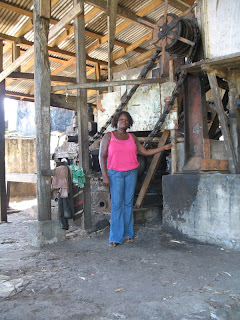Please understand, it’s not we who change our minds, it’s the weather that gets all moody. From wanting to put the Grenadines under a pall, it decided instead to harrass Grenada and Trinidad. (It had probably heard about our altered plans.)
We learned this from Chris Parker’s report on Wednesday morning. We were still in Tyrrel Bay having spent another night listening to the wind’s lament and the rain’s fury. Dampness was everywhere. The few pieces of laundry hung on the lifelines to dry had grown, over the days, to such an extent that it is surprising we still had clothing to wear. All of it drooping moistly, just as wet or wetter than when it had first felt a clothespin.
WW went into captain mode. He decided we would head north to the Grenadines. First we needed to clear out from Grenada. He took Boffo in and caught the EC $3 bus rather than an EC $35 taxi to Hillsborough and the customs and immigration office. In the pouring rain, of course. I stayed aboard, closed hatches, scrubbed soles, and tried to reach our guests to have them revert to Plan A. For some reason, my phone wouldn’t work. It and WW’s are on the same plan...Rogers hates me. Contacting the guests had to wait for his return but we got through at once and the required information was exchanged. It was 10 a.m.
Now all we had to do was get from Carriacou to Admiralty Bay, Bequia, a run of about 35 nm. We could clear into St. Vincent there, in Port Elizabeth, then cross over to Lagoon Marina in Blue Lagoon, St. Vincent, to meet our guests in the evening.
We cleared the northern Tyrrel Bay headland at 10:30 a.m. and set a course that would take us past Union Island and south of the Tobago Cays. Then we’d have a nice reach straight up to Bequia. We watched the foul weather and Carriacou recede and the fair weather over Union Island ahead. Sitting on deck, I was suddenly bathed in sunlight. I actually whooped for joy.
What lay astern over Carriacou

Off the Tobago Cays lies the extensive and mean World’s End Reef. Strong currents run through the North and South Mayreau Channels on either side of it. Waves that have worked their way from Africa pile up on its eastern edge then try to fight their way back. The waters are...active. The going there was a bit rollercoasterish. WW said we’d change course and raise sails after we were our of “this maelstrom”. That happened shortly after 2 p.m.
The mainsail went up first, then the genny. WW shut down the port engine, but kept the starboard going at fairly low revs. We wanted to get to Admiralty Bay before full dark. The winds were 16 to 20 nm/h right on our starboard quarter. WW trimmed the sails, tweaked and adjusted. I was below when he leaned in to grab the camera. “I want a photo of our wake at 8 knots,” he announced with pride.
Django's wake at 8 knots
Django's SOG (speed over ground)
I snoozed for half an hour then came on deck. Things had changed. The wind had shifted and we’d slowed a bit as a result, still making 5 or 6 knots. Over the Atlantic, weather was arriving. We could see Bequia about 10 nm ahead, Mustique off to starboard. We plowed on. We took the sails in as we saw the black clouds draw nearer. At about 4:15 p.m., the squall hit.
Wicked squall coming at us from Bequia
WW, at the wheel, was drenched in seconds. I went out long enough to establish I didn’t want to be there. We both kneeled on the saloon bench and peered out the forward hatches into the murk. Visibility was less than 5 nm since the plotter said that was the distance to Bequia and we couldn’t see land. Finally, it began to clear. We were right on course to clear West Cay and hang a starboard into Admiralty Bay.
We made our way slowly into the crowded Port Elizabeth harbour. It was too dark for us to try to pick up a mooring, so we dropped our hook. It dragged. We took it in and dropped it again. It dragged. We went to sleep with the anchor alarm on, letting us know if we’ve moved more than 0.01 nm from our position when it is set. It went off several times during the night as we moved gently out into the bay. There was no one behind us, lots of room to drag.
This morning, we raised anchor, tied down Tramp, and headed for St. Vincent. WW decided it would be just as easy to make the short crossing, get into Lagoon Marina and take a bus or taxi to Kingstown to clear in.
So, here we are, almost to Kingstown. I’d best go crew.
Arriving at St. Vincent


















































